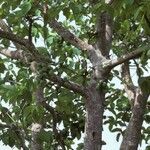A fig. It is a large tree. It grows 5-20 m tall. The crown is wide and spreading. Sometimes it has buttresses near the base. The bark is rough and grey. On leafy twigs the bark is often white or hairy. The skin flakes off when dry. The leaves are stiff. They are dark green and wide oval shape. The base is heart shaped. The leaves are about 20 cm long and 4-24 cm wide. The edge of the leaf has wide teeth and is often wavy. The leaf stalk is 2-11 cm long. There are 4-6 main pairs of veins. The lowest ones reach beyond the middle of the leaf blade. The fruit are figs which occur singly. They are 3-6 cm across. They are round and yellow-orange with orange stripes when ripe. They grow beside or just below the leaves. They grow on short woody stalks. They are succulent and edible.
Leaf lamina ovate to cordiform or ± deltate, 4–24(36) x 3–24(30) cm., coriaceous to subcoriaceous, apex acute to subobtuse or very shortly acuminate, base obtuse to truncate or cordate, margin coarsely and obtusely dentate to repand, sometimes subentire; superior surface smooth and glabrous or puberulous on the main veins, sometimes scabridulous and hirtellous to pubescent; lateral veins 5–8 pairs; petiole 2–11(13.5) cm. long, 1–3 mm. thick, glabrous, appressed puberulous or sometimes hirtellous to tomentose, indumentum white, epidermis flaking off when dry; stipules 1–3 cm. long, ciliolate in the lower part, appressed puberulous or subsericeous, caducous.
Receptacle subglobose to obovoid, c. 20 mm. in diam. when fresh, 15 mm. in diam. when dry, ± densely white to yellowish puberulous to hirtellous or tomentose, tomentellous near the ostiole, or glabrous; yellowish to orange at maturity with longitudinal orange to reddish stripes.
Figs solitary in the leaf axils or just below the leaves, occasionally on leafless branchlets up to 30 cm. long on the older wood; peduncle 2–12 mm. long, 4–6 mm. thick; basal bracts c. 2 mm. long.
Leafy twigs 2–10 mm. thick, glabrous or sparsely appressed puberulous, sometimes hirtellous or tomentose, indumentum white, periderm flaking off when dry.
Tree up to 10(20) m. tall.





